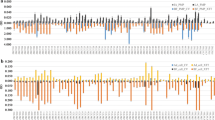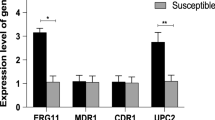Abstract
Candida tropicalis has been reported to be one of the Candida species which is most likely to cause bloodstream and urinary tract infections in hospitalized patients. Accordingly, the aim of this study was to characterize the virulence of C. tropicalis by assessing antifungal susceptibility and comparing the expression of several virulence factors. This study was conducted with seven isolates of C. tropicalis from urine and blood cultures and from central venous catheter. C. tropicalis ATCC 750 was used as reference strain. Yeasts adhered (2 h) to epithelial cells and silicone and 24 h biofilm biomass were determined by crystal violet staining. Pseudohyphae formation ability was determined after growth in fetal bovine serum. Enzymes production (hemolysins, proteases, phospholipases) was assessed by halo formation on agar plates. Susceptibility to antifungal agents was determined by E-test. Regarding adhesion, it can be highlighted that C. tropicalis strains adhered significantly more to epithelium than to silicone. Furthermore, all C. tropicalis strains were able to form biofilms and to express total hemolytic activity. However, protease was only produced by two isolates from urine and by the isolates from catheter and blood. Moreover, only one C. tropicalis (from catheter) was phospholipase positive. All isolates were susceptible to voriconazole, fluconazole and amphotericin B. Four strains were susceptible-dose dependent to itraconazole and one clinical isolate was found to be resistant.


Similar content being viewed by others
References
Lundstrom T, Sobel J. Nosocomial candiduria: a review. Clin Infect Dis. 2001;32:1602–7. doi:10.1086/320531.
Colombo AL, Nucci M, Park BJ, Nouér SA, Arthington-Skaggs B, da Matta DA, et al. Epidemiology of candidemia in Brazil: a nationwide sentinel surveillance of candidemia in eleven medical centers. J Clin Microbiol. 2006;44:2816–23. doi:10.1128/JCM.00773-06.
Asmundsdottir LR, Erlendsdottir H, Haraldsson G, Guo H, Xu J, Gottfredsson M. Molecular epidemiology of candidemia: evidence of clusters of smoldering nosocomial infections. Clin Infect Dis. 2008;47:17–24. doi:10.1086/589298.
Kauffman CA, Vazquez JA, Sobel JD, Gallis HA, McKinsey DS, Karchmer AW, et al. Prospective multicenter surveillance study of funguria in hospitalized patients. Clin Infect Dis. 2000;30:14–8. doi:10.1086/313583.
Álvarez-Lerma F, Nolla-Salas J, León C, Palomar M, Jordá R, Carrasco N, et al. Candiduria in critically ill patients admitted to intensive care medical units. Intensive Care Med. 2003;29:1069–76. doi:10.1007/s00134-003-1807-y.
Nucci M, Colombo AL. Candidemia due to Candida tropicalis: clinical, epidemiologic, and microbiologic characteristics of 188 episodes occurring in tertiary care hospitals. Diagn Microbiol Infect Dis. 2007;58:77–82. doi:10.1016/j.diagmicrobio.2006.11.009.
Rho J, Shin JH, Song JW, Park MR, Kee SJ, Jang SJ, et al. Molecular investigation of two consecutive nosocomial clusters of Candida tropicalis candiduria using pulsed-field gel electrophoresis. J Microbiol. 2004;42:80–6. doi:10.1016/j.diagmicrobio.2006.09.009
Krcmery V, Barnes AJ. Non-albicans Candida spp. causing fungaemia: pathogenicity and antifungal resistance. J Hosp Infect. 2002;50:243–60. doi:10.1053/jhin.2001.1151.
Okawa Y, Miyauchi M, Kobayashi H. Comparison of pathogenicity of various Candida tropicalis strains. Biol Pharm Bull. 2008;31:1507–10. doi:10.1128/JCM.43.11.5593-5600.2005
Furlaneto-Maia L, Specian A, Bizerra F, de Oliveira M, Furlaneto M. In vitro evaluation of putative virulence attributes of oral isolates of Candida spp. obtained from elderly healthy individuals. Mycopathologia. 2008;166:209–17. doi:10.1007/s11046-008-9139-7.
Tamura NK, Negri MFN, Bonassoli LA, Svidzinski TIE. Fatores de virulência de Candida spp isoladas de cateteres venosos e mãos de servidores hospitalares. Rev Soc Bras Med Trop. 2007;40:91–3. doi:10.1590/S0037-86822007000100021.
Manns JM, Mosser DM, Buckley HR. Production of a hemolytic factor by Candida albicans. Infect Immun. 1994;62:5154–6. doi:10.1590/S0037-86822009000200029.
Luo G, Samaranayake LP, Yau JYY. Candida species exhibit differential in vitro hemolytic activities. J Clin Microbiol. 2001;39:2971–4. doi:10.1128/JCM.39.8.2971-2974.2001.
Bizerra FC, Nakamura CV, de Poersch C, Estivalet Svidzinski TI, Borsato Quesada RM, Goldenberg S, et al. Characteristics of biofilm formation by Candida tropicalis and antifungal resistance. FEMS Yeast Res. 2008;8:442–50. doi:10.1111/j.1567-1364.2007.00347.x.
Maki DG, Weise CE, Sarafin HW. A semiquantitative culture method for identifying intravenous-catheter-related infection. N Engl J Med. 1977;296:1305–9.
Kurtzman CP, Fell JW (1998) The yeasts, a taxonomics. 4th ed. Elsevier Science.
Kanbe T, Horii T, Arishima T, Ozeki M, Kikuchi A. PCR-based identification of pathogenic Candida species using primer mixes specific to Candida DNA topoisomerase II genes. Yeast. 2002;19:973–89. doi:10.1002/yea.892.
Henriques M, Azeredo J, Oliveira R. Candida species adhesion to oral epithelium: factors involved and experimental methodology used. Crit Rev Microbiol. 2006;32:217–26. doi:10.1080/10408410601023524.
Rüchel R. Proteinases of pathogenic fungi. Mycoses. 1999;42:48–52.
Price M, Wilkinson I, Gentry L. Plate method for detection of phospholipase activity in Candida albicans. Sabouraudia. 1982;20:7–14. doi:10.1159/000072448
Clinical and Laboratory Standards Institute (CLSI). Reference method for broth dilution antifungal susceptibility testing of yeasts; approved standard. 3rd edition (M27-A3). CLSI document M27-A3. Wayne, PA, USA: Clinical and Laboratory Standards Institute.
Lai C-C, Tan C-K, Huang Y-T, Shao P-L, Hsueh P-R. Current challenges in the management of invasive fungal infections. J Infect Chemother. 2008;14:77–85. doi:10.1007/s10156-007-0595-7.
Schelenz S. Management of candidiasis in the intensive care unit. J Antimicrob Chemother. 2008;61:31–4. doi:10.1093/jac/dkm430.
Zaugg C, Borg-von Zepelin M, Reichard U, Sanglard D, Monod M. Secreted aspartic proteinase family of Candida tropicalis. Infect Immun. 2001;69:405–12. doi:10.1128/IAI.69.1.405-412.2001.
Sohn K, Senyürek I, Fertey J, Königsdorfer A, Joffroy C, Hauser N, et al. An in vitro assay to study the transcriptional response during adherence of Candida albicans to different human epithelia. FEMS Yeast Res. 2006;6:1085–93. doi:10.1111/j.1567-1364.2006.00130.x.
Bendel C, Hostetter M. Distinct mechanisms of epithelial adhesion for Candida albicans and Candida tropicalis. Identification of the participating ligands and development of inhibitory peptides. J Clin Invest. 1993;92:1840–9. doi:10.1172/JCI116775.
Panagoda GJ, Ellepola ANB, Samaranayake LP. Adhesion of Candida parapsilosis to epithelial and acrylic surfaces correlates with cell surface hydrophobicity. Mycoses. 2001;44:29–35. doi:10.1046/j.1439-0507.2001.00611.x.
Lyon PJ, Resende MA. Correlation between adhesion, enzyme production, and susceptibility to fluconazole in Candida albicans obtained from denture wearers. Oral Surg Oral Med Oral Pathol Oral Radiol Endod. 2006;102:632–8. doi:10.1016/j.tripleo.2005.12.015.
Henriques M, Azeredo J, Oliveira R. The involvement of physico-chemical interactions in the adhesion of Candida albicans and Candida dubliniensis to epithelial cells. Mycoses. 2007;50:391–6. doi:10.1111/j.1439-0507.2007.01387.x.
Chandra J, Kuhn DM, Mukherjee PK, Hoyer LL, McCormick T, Ghannoum MA. Biofilm formation by the fungal pathogen Candida albicans: development, architecture, and drug resistance. J Bacteriol. 2001;183:5385–94. doi:10.1128/JB.183.18.5385-5394.2001.
Douglas LJ. Candida biofilms and their role in infection. Trends Microbiol. 2003;11:30–6. doi:10.1016/S0966-842X(02)00002-1.
Silva S, Henriques M, Martins A, Oliveira R, Williams D, Azeredo J. Biofilms of non-Candida albicans Candida species: quantification, structure and matrix composition. Med Mycol. 2009;20:1–9. doi:10.1080/13693780802549594.
Shin JH, Kee SJ, Shin MG, Kim SH, Shin DH, Lee SK, et al. Biofilm production by isolates of Candida species recovered from nonneutropenic patients: comparison of bloodstream isolates with isolates from other sources. J Clin Microbiol. 2002;40:1244–8. doi:10.1128/JCM.40.4.1244-1248.2002.
Hawser SP, Douglas LJ. Biofilm formation by Candida species on the surface of catheter materials in vitro. Infect Immun. 1994;62:915–21.
Yang Y. Virulence factors of Candida species. J Microbiol Immunol Infect. 2003;36:223–8. doi:10.1590/S0037-86822009000200029
Fu Y, Luo G, Spellberg BJ, Edwards JE Jr, Ibrahim AS. Gene overexpression/suppression analysis of candidate virulence factors of Candida albicans. Eukaryot Cell. 2008;7:483–92. doi:10.1128/EC.00445-07.
da Costa K, Ferreira J, Komesu M, Candido R. Candida albicans and Candida tropicalis in oral candidosis: quantitative analysis, exoenzyme activity, and antifungal drug sensitivity. Mycopathologia. 2009;167:73–9. doi:10.1007/s11046-008-9154-8.
Kumar VG, Latha R, Vedhagiri K, Sathiamoorthi T, Jayarani G, Sasikala R, et al. Phospholipase C, proteinase and hemolytic activities of Candida spp. isolated from pulmonary tuberculosis patients. J Mycol Med. 2009;19:3–10. doi:10.1016/j.mycmed.2008.11.002.
Gokce G, Cerikcioglu N, Yagci A. Acid proteinase, phospholipase, and biofilm production of Candida species isolated from blood cultures. Mycopathologia. 2007;164:265–9. doi:10.1007/s11046-007-9053-4.
Johnson E, Espinel-Ingroff A, Szekely A, Hockey H, Troke P. Activity of voriconazole, itraconazole, fluconazole and amphotericin B in vitro against 1763 yeasts from 472 patients in the voriconazole phase III clinical studies. Int J Antimicrob Agents. 2008;32:511–4. doi:10.1016/j.ijantimicag.2008.05.023.
Panizo MM, Reviákina V, Dolande M, Selgrad S. Candida spp. in vitro susceptibility profile to four antifungal agents. Resistance surveillance study in Venezuelan strains. Med Mycol. 2009;47:137–43. doi:10.1080/13693780802144339.
Author information
Authors and Affiliations
Corresponding author
Rights and permissions
About this article
Cite this article
Negri, M., Martins, M., Henriques, M. et al. Examination of Potential Virulence Factors of Candida tropicalis Clinical Isolates From Hospitalized Patients. Mycopathologia 169, 175–182 (2010). https://doi.org/10.1007/s11046-009-9246-0
Received:
Accepted:
Published:
Issue Date:
DOI: https://doi.org/10.1007/s11046-009-9246-0




